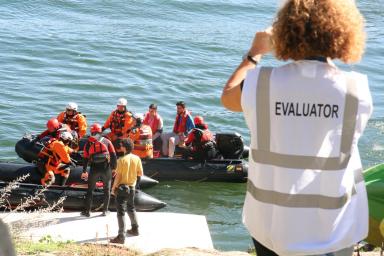

Emergency Drills: the Most Effective Way to Save Lives : the Most Effective Way to Save Lives
Emergency and evacuation drills save thousands of lives every year. Experts discuss the most effective techniques: The Director-General of Civil Protection and Emergencies of Spain’s Interior Ministry and officers from the Professional Association of Fire-fighter Technicians and the technical services of Cepretec (Cepreven Group).
Spain has come a long way in emergency prevention, according to the Professional Association of Fire-fighter Technicians (APTB). “Some years ago, drills were almost a token gesture on any type of premises, but today they are essential for putting into practice evacuation plans in large buildings, whatever their use. New legislation and increased awareness among the different stakeholders have led to a stronger emergency culture.”
The natural next step is to encourage this effort in other kinds of building, especially among young people, where awareness-raising work is still needed. “At APTB, we’re very clear that encouraging prevention needs to start at school. That’s why we’re partnering with the MAPFRE Foundation to organise Fire Prevention Week during the school term. Primary school children learn how to escape from a fire, but more importantly, how to prevent it.”
One of the main parts of the drills is about evacuation routes. “It’s essential for these buildings to have a system to detect a fire, sound the alarm and put it out. But it’s even more important to raise awareness about the importance of having properly marked escape routes and to keep doors clear and not closed with chains or locks.” So, our association warns people that “unless you take this maxim into account, when there’s a major fire in a large building, the fire-fighters’ work will be hampered in a way that no operation or drill can prevent.”
The Job Rotation Problem
Miriam Pastor Seller is an architect and member of the Technical Services Section of Cepretec (Cepreven Group). She explains that both the self-protection regulations (Royal Decree 393/2007) and those on preventing occupational hazards, including Law 31/1995, mention the need to take fire-fighting and staff evacuation measures. “Checking that the planned system and the building’s equipment actually work, needs practical exercises such as drills.”
According to Pastor, “although the effort by ‘volunteers’ is beneficial, in practice job roles change in so many ways that can make drills less effective of the development of such drills. For example, the person doing the job, and shift changes during the day.” In her opinion, “these changes should involve the strengthening practical training for every conceivable use of a building, both industrial and non-industrial, because it’s generally difficult for all members of the teams to take part in the drills that can be scheduled.”
To encourage building users and emergency team members to get more involved, given that they’re expected to react flexibly, it’s helpful to consider a variety of emergency scenarios. That way, “depending on the goal of each drill, it’ll be possible to assess how all or some of those involved behave in the different phases of an emergency, wholly or partially.”
Coordination: The Key Factor
Leonardo Marcos is Director General for Civil Protection and Emergencies with Spain’s Ministry of the Interior. He explains that the national General Emergency Plan for the Civil Protection System is the primary organisation for dealing with all types of civil protection emergencies. It provides for “periodic exercises and drills, in collaboration with the other government bodies and services that make up the National Civil Protection System, with the aim of maintaining all the plan’s procedures, mechanisms and personnel fully operational.”
He adds that “each regional administration’s plans, and the national and regional special plans, also provide for exercises and drills to ensure operability.”
In this context, coordination is “the key factor that’s tested in exercises and drills,” both between management centres and between those in the field. “It’s also important to include the media and the public in these exercises to involve them in their fundamental role in successfully resolving an emergency.”
Marcos explains that the Civil Protection and Emergencies System has organised an extensive programme of exercises. “One example is the EURiwaterex exercise for a flooding scenario in the Jarama river basin, both the involving teams from other countries.” And he adds that “similarly, we encourage participation by Spanish operatives in international exercises, particularly those organised by the European Mechanism. Recently, we carried out a Tsunami Plan exercise in collaboration with the Andalusian regional government.” He also adds that “this Directorate-General for Civil Protection and Emergencies is responsible for drawing up an Annual Exercise Plan for the National Civil Protection System.”





